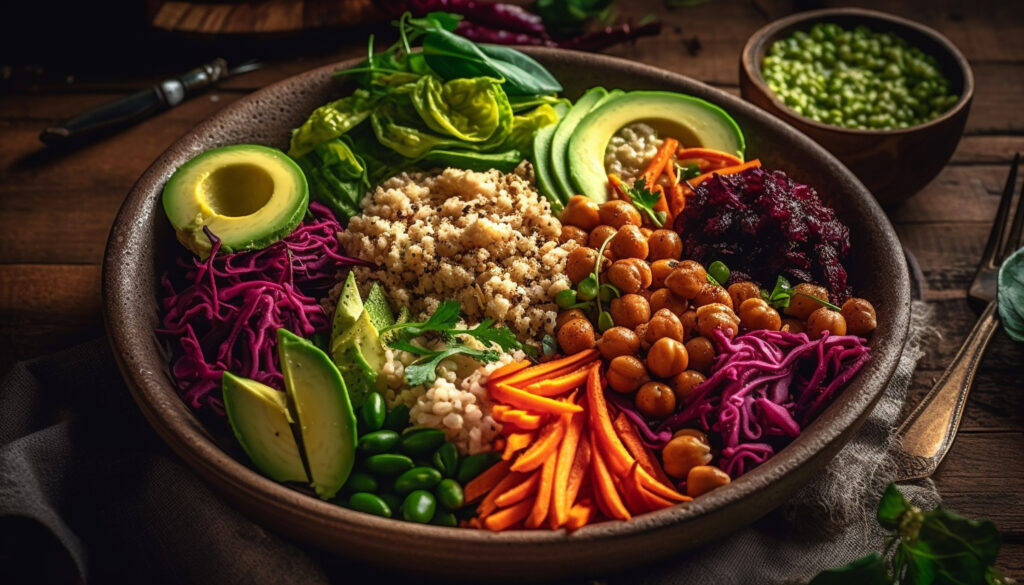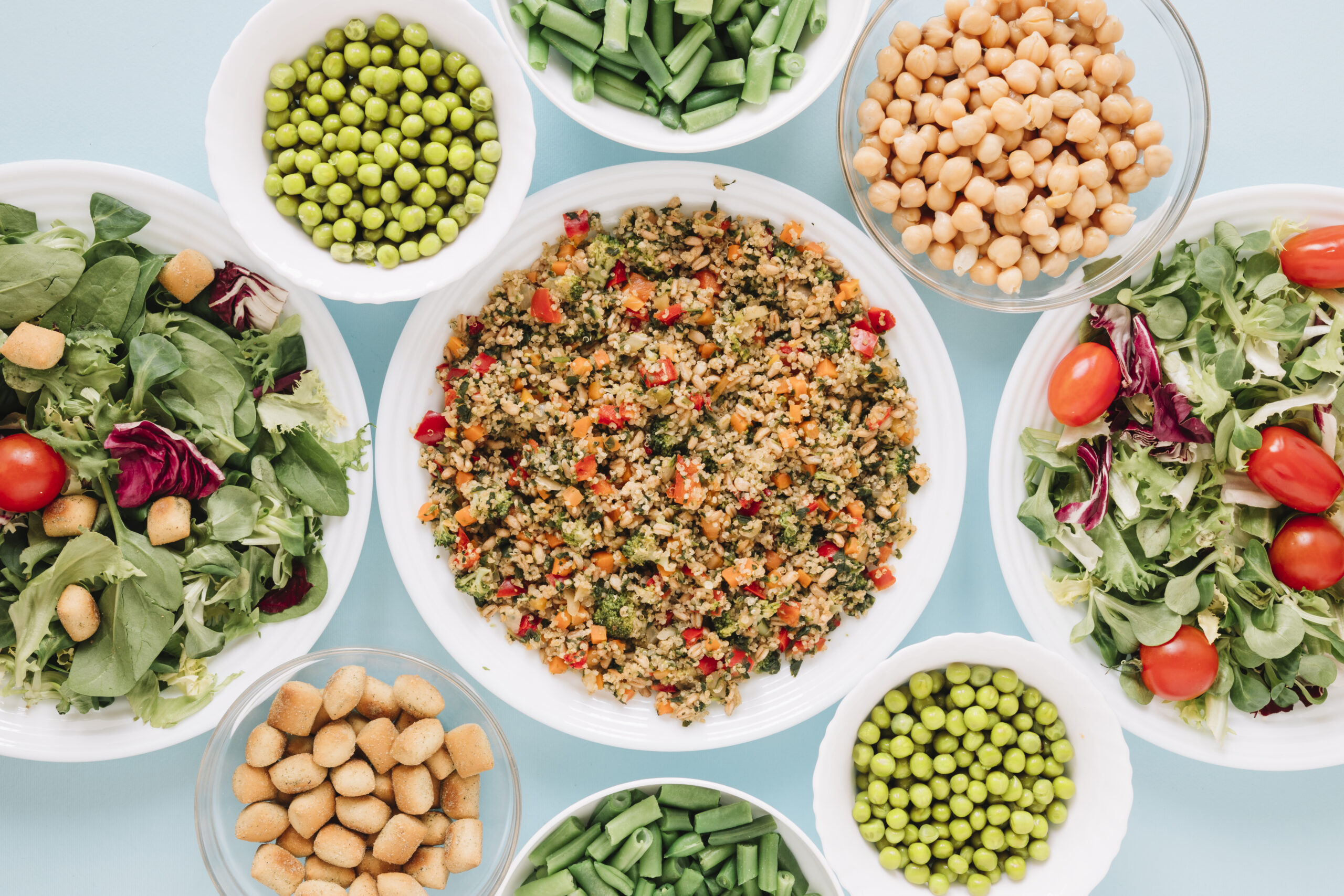Intorduction:
Are you trying to lose those excess pounds and want to do it in a healthy and effective way? There’s nowhere else to look! You could find that going plant-based for 30 days is the best course of action. This post will cover all the information you require to start a plant-based diet for weight loss, including its advantages, a how-to guide, and some delectable recipes. Now let’s get started.
What is a Plant-Based Diet?
Benefits of a Plant-Based Diet for Weight Loss

A plant-based diet is a way of eating that focuses primarily on foods derived from plants. This includes not only fruits and vegetables but also nuts, seeds, oils, whole grains, legumes, and beans. It does not necessarily mean that you are vegetarian or vegan and completely give up meat or animal products. Rather, you are proportionately choosing more of your foods from plant sources.
Plant-based diets can vary in their strictness. Some people follow a completely vegan diet, excluding all animal products, while others may include small amounts of meat, dairy, or eggs. The key is that the majority of the diet comes from plant foods, which are rich in essential nutrients, fiber, and antioxidants.
The benefits of a plant-based diet include a low of heart disease, high blood pressure, diabetes, and certain types of cancer. Additionally, it can help with weight management and improve digestion. A plant-based diet can also contribute to better overall health and wellness by emphasizing whole, minimally processed foods
 Adopting a plant-based diet can be a highly effective strategy for weight loss, offering numerous benefits that go beyond just shedding pounds. Here are some key advantages:
Adopting a plant-based diet can be a highly effective strategy for weight loss, offering numerous benefits that go beyond just shedding pounds. Here are some key advantages:
Lower Calorie Density: Plant-based foods, especially fruits, vegetables, and whole grains, tend to have fewer calories per volume compared to animal products. This allows you to eat satisfying portions without consuming excessive calories, making it easier to maintain a calorie deficit and lose weight.
High in Fiber: Plant-based diets are rich in dietary fiber, which promotes a feeling of fullness and reduces hunger. Fiber also helps regulate blood sugar levels, preventing the spikes and crashes that can lead to overeating.
Nutrient-rich foods: By focusing on whole, unprocessed plant foods, you’re more likely to consume a diet rich in essential nutrients, including vitamins, minerals, and antioxidants. This can improve overall health and support weight loss by optimizing your body’s metabolic processes.
Reduced Intake of Processed Foods: Plant-based diets often limit or exclude highly processed foods that are high in added sugars, unhealthy fats, and empty calories. This can help reduce overall calorie intake and improve the quality of your diet.
Healthy Fats: While plant-based diets do include fats from sources like avocados, nuts, and seeds, these are healthier fats that can support weight loss. They provide essential fatty acids without the saturated fats found in many animal products.
Improved Digestion: The high fiber content in plant-based foods aids digestion and promotes regular bowel movements, which can help prevent bloating and support a flatter stomach.
Lower Risk of Chronic Diseases: Weight gain and obesity are often linked to chronic diseases like type 2 diabetes, heart disease, and certain cancers. A plant-based diet can help reduce the risk of these conditions, supporting overall health and making weight loss easier to maintain.
Increased Energy Levels: Many people report higher energy levels on a plant-based diet, which can encourage more physical activity and further support weight loss.
Getting Started: Transitioning to a Plant-Based Diet

Transitioning to a plant-based diet can seem daunting, but with a bit of planning and some practical tips, you can make the shift smoothly and enjoyably. Here’s how to get started:
1. Educate Yourself
Understanding the principles of a plant-based diet is crucial. Learn about the various food groups and how to balance your meals to ensure you get all the essential nutrients. Reading books, watching documentaries, and following reputable plant-based bloggers can provide valuable insights.
2. Start Gradually
You don’t need to overhaul your diet overnight. Begin by incorporating more plant-based meals into your weekly routine. Start with one or two meatless days per week and gradually increase from there. This approach allows your palate and digestion to adjust.
3. Stock Your Pantry
Fill your pantry with plant-based staples such as beans, lentils, quinoa, brown rice, oats, nuts, seeds, and whole-grain pasta. Having these items on hand makes it easier to prepare plant-based meals.
4. Explore Plant-Based Proteins
Familiarize yourself with plant-based protein sources like tofu, tempeh, edamame, chickpeas, lentils, and black beans. Experiment with different recipes to find what you enjoy the most.
5. Plan Your Meals
Meal planning can help you stay on track and make the transition smoother. Plan your meals for the week, create a shopping list, and prep ingredients in advance. This can save time and reduce the temptation to revert to old eating habits.
6. Try New Recipes
Expanding your culinary repertoire is essential for a successful transition. Look for plant-based cookbooks, websites, and apps to find new and exciting recipes. Trying different cuisines can also introduce you to a variety of flavors and ingredients.
7. Make Simple Swaps
Replace animal products with plant-based alternatives. Use almond or soy milk instead of dairy milk, try plant-based yogurt, and explore vegan cheese options. These swaps can help you gradually shift to a plant-based diet without feeling deprived.
8. Eat a Variety of Foods
Eating a wide variety of fruits, vegetables, whole grains, and legumes ensures you get a broad spectrum of nutrients. Aim to fill your plate with a colorful array of foods to maximize your nutrient intake.
9. Stay Hydrated
Drink plenty of water throughout the day to stay hydrated. Herbal teas and fresh fruit juices can also be good additions to your beverage choices.
10. Listen to Your Body
Pay attention to how your body responds to the changes in your diet. Everyone’s nutritional needs are different, so it’s important to adjust your eating habits based on what makes you feel your best.
11. Join a Community
Connecting with others who are also following a plant-based diet can provide support and inspiration. Join online forums, social media groups, or local meetups to share experiences, recipes, and tips.
12. Be Patient and Flexible
Transitioning to a plant-based diet is a journey, not a race. Be patient and understand that making mistakes or having occasional setbacks is okay. Flexibility and persistence are key to long-term success.
Mechanisms of Fat Loss on a Plant-Based Diet
 1. Improved Metabolism
1. Improved Metabolism
A nutrient-dense plant-based diet can boost your metabolism. The vitamins and minerals found in plants are essential for metabolic processes, helping your body convert food into energy more efficiently. Improved metabolism means your body burns calories more effectively, aiding in fat loss.
2. Hormonal Balance
Hormones play a crucial role in weight management. A plant-based diet helps balance hormones like insulin, leptin, and cortisol, which are involved in fat storage and appetite regulation. Balanced hormones can help reduce fat accumulation and support weight loss.
3. Enhanced Satiety
Foods rich in fiber and water content, common in a plant-based diet, promote satiety. Feeling full for longer periods helps control appetite and reduces overall calorie intake. This makes it easier to maintain a calorie deficit, which is necessary for fat loss.
4. Reduced Inflammation
Chronic inflammation can interfere with weight loss efforts. Plant-based diets are rich in anti-inflammatory compounds, such as antioxidants and phytonutrients, which help reduce inflammation in the body. Lower inflammation levels can improve metabolic health and promote fat loss.
Sample 30-Day Meal Plan
 Here’s a sample meal plan to guide you through the first week. Feel free to mix and match based on your preferences.
Here’s a sample meal plan to guide you through the first week. Feel free to mix and match based on your preferences.
Day 1
- Breakfast: Smoothie bowl with spinach, banana, berries, and chia seeds
- Lunch: Quinoa salad with chickpeas, cucumber, tomatoes, and avocado
- Dinner: Stir-fried vegetables with tofu and brown rice
Day 2
- Breakfast: Overnight oats with almond milk, flaxseeds, and fresh fruit
- Lunch: Lentil soup with whole-grain bread
- Dinner: Spaghetti with marinara sauce and a side of steamed broccoli
Day 3
- Breakfast: Whole grain toast with avocado and cherry tomatoes
- Lunch: Mixed greens salad with walnuts, cranberries, and a balsamic vinaigrette
- Dinner: Black bean tacos with corn tortillas, salsa, and guacamole
Day 4
- Breakfast: Chia pudding with coconut milk and fresh berries
- Lunch: Hummus wrap with spinach, cucumber, and bell peppers
- Dinner: Sweet potato and black bean chili
Day 5
- Breakfast: Smoothie with kale, pineapple, and coconut water
- Lunch: Quinoa and vegetable stuffed bell peppers
- Dinner: Lentil curry with basmati rice
Day 6
- Breakfast: Oatmeal with walnuts, bananas, and a drizzle of maple syrup
- Lunch: Greek salad with tofu feta
- Dinner: Vegetable stir-fry with soba noodles
Day 7
- Breakfast: Vegan pancakes with blueberries and a touch of agave syrup
- Lunch: Buddha bowl with brown rice, chickpeas, avocado, and tahini dressing
- Dinner: Stuffed zucchini boats with quinoa and marinara sauce
Delicious Plant-Based Recipes
1. Chickpea and Spinach Curry
Ingredients:
- 1 can chickpeas, drained and rinsed
- 1 onion, chopped
- 2 garlic cloves, minced
- 1 can coconut milk
- 2 cups spinach
- 1 tbsp curry powder
- Salt and pepper to taste
Instructions:
- Sauté the onion and garlic in a pan until translucent.
- Add the chickpeas and curry powder, stirring well.
- Pour in the coconut milk and simmer for 10 minutes.
- Add the spinach and cook until wilted.
- Season with salt and pepper. Serve with brown rice.
2. Quinoa Salad with Avocado and Black Beans
Ingredients:
- 1 cup quinoa, cooked
- 1 avocado, diced
- 1 can black beans, drained and rinsed
- 1 red bell pepper, chopped
- 1 small red onion, chopped
- Juice of 1 lime
- Salt and pepper to taste
Instructions:
- In a large bowl, combine quinoa, black beans, bell pepper, and red onion.
- Add the avocado and gently mix.
- Squeeze lime juice over the salad, and season with salt and pepper.
- Serve chilled or at room temperature.
3. Sweet Potato and Black Bean Tacos
Ingredients:
- 2 sweet potatoes, peeled and cubed
- 1 can black beans, drained and rinsed
- 1 tsp cumin
- 1 tsp paprika
- 1/2 tsp garlic powder
- Corn tortillas
- Fresh cilantro, chopped
- Lime wedges
Instructions:
- Preheat oven to 400°F (200°C). Toss sweet potatoes with cumin, paprika, and garlic powder. Roast for 25 minutes.
- Heat black beans in a pan until warm.
- Assemble tacos by placing sweet potatoes and black beans in corn tortillas.
- Garnish with fresh cilantro and a squeeze of lime juice.
Staying Motivated and Overcoming Challenges

1. Find a Support System
Having friends or family join you on your plant-based journey can provide motivation and accountability.
2. Keep a Food Journal
Tracking what you eat can help you stay mindful of your food choices and progress.
3. Celebrate Small Wins
Acknowledge and celebrate your achievements, no matter how small. This will keep you motivated to continue.
4. Stay Hydrated
Drinking plenty of water is crucial for weight loss and overall health.
5. Be Patient
Weight loss is a journey. Be patient with yourself and understand that results take time.
Common Myths about Plant-Based Diets

Switching to a plant-based diet can be met with skepticism and misinformation. Understanding and debunking common myths can help you make informed decisions and stay confident in your dietary choices. Here are some prevalent myths about plant-based diets and the truths behind them:
1. Myth: Plant-Based Diets Lack Protein
Truth: Plant-based diets can provide ample protein through sources such as beans, lentils, tofu, tempeh, quinoa, nuts, seeds, and whole grains. By eating a variety of these foods, you can easily meet your protein needs without animal products.
2. Myth: You Need Dairy for Strong Bones
Truth: While dairy is a common source of calcium, many plant-based foods are rich in calcium, including fortified plant milks, leafy green vegetables, almonds, tahini, and tofu. Additionally, weight-bearing exercise and adequate vitamin D intake are crucial for bone health.
3. Myth: Plant-Based Diets Are Expensive
Truth: Plant-based diets can be very budget-friendly, especially when focusing on whole foods like grains, beans, legumes, and seasonal vegetables. Processed plant-based foods can be pricey, but they are not necessary for a healthy diet.
4. Myth: You Can’t Get Enough Iron from Plants
Truth: Iron is available in plant foods such as lentils, chickpeas, beans, tofu, spinach, and fortified cereals. Pairing these foods with vitamin C-rich foods (like citrus fruits, bell peppers, and tomatoes) can enhance iron absorption.
5. Myth: Plant-Based Diets Are Bland and Boring
Truth: A plant-based diet can be incredibly diverse and flavorful. With the wide variety of fruits, vegetables, grains, legumes, herbs, and spices available, there are countless delicious and exciting recipes to explore.
6. Myth: Plant-Based Eaters Are Always Hungry
Truth: When well-planned, plant-based meals are satisfying and nutrient-dense, providing adequate fiber, protein, and healthy fats that keep you full and energized throughout the day.
7. Myth: It’s Difficult to Eat Out on a Plant-Based Diet
Truth: Many restaurants now offer plant-based options, and with a little creativity, you can often modify menu items to fit your dietary preferences. Ethnic cuisines such as Indian, Thai, Mexican, and Mediterranean typically have many plant-based dishes.
8. Myth: Plant-Based Diets Are Only for Weight Loss
Truth: While many people adopt a plant-based diet for weight loss, it offers numerous other benefits, including improved heart health, better digestion, reduced inflammation, and a lower risk of chronic diseases.
9. Myth: You Can’t Build Muscle on a Plant-Based Diet
Truth: Many athletes and bodybuilders thrive on plant-based diets. With proper planning and consumption of protein-rich plant foods, along with regular strength training, you can build and maintain muscle mass effectively.
10. Myth: Plant-Based Diets Are Nutritionally Incomplete
Truth: A well-balanced plant-based diet can provide all essential nutrients. However, like any diet, it requires planning. Nutrients to pay special attention to include vitamin B12 (which may require supplementation), vitamin D, omega-3 fatty acids, iron, calcium, and zinc.
Conclusion
Adopting a 30-day plant-based diet can be a transformative experience for both your body and mind. By focusing on whole, nutrient-rich foods, you can achieve your weight loss goals while improving your overall health. Remember to set clear goals, plan your meals, and stay motivated throughout your journey. With delicious recipes and a sustainable approach, you’ll find that losing weight on a plant-based diet is not only achievable but also enjoyable. Here’s to a healthier, happier you.

